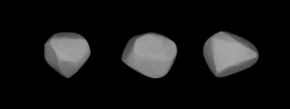336 Lacadiera
Appearance
 A three-dimensional model of 336 Lacadiera based on its light curve | |
| Discovery | |
|---|---|
| Discovered by | Auguste Charlois |
| Discovery date | 19 September 1892 |
| Designations | |
| (336) Lacadiera | |
| Pronunciation | Occitan: [lakaˈdjeɾɔ] |
Named after | La Cadiera |
| 1892 D | |
| Main belt | |
| Orbital characteristics[1] | |
| Epoch 31 July 2016 (JD 2457600.5) | |
| Uncertainty parameter 0 | |
| Observation arc | 123.57 yr (45133 d) |
| Aphelion | 2.4661 AU (368.92 Gm) |
| Perihelion | 2.0373 AU (304.78 Gm) |
| 2.2517 AU (336.85 Gm) | |
| Eccentricity | 0.095224 |
| 3.38 yr (1234.2 d) | |
| 324.173° | |
| 0° 17m 30.12s / day | |
| Inclination | 5.6530° |
| 235.044° | |
| 2023-Sep-03 | |
| 31.129° | |
| Physical characteristics | |
| Dimensions | 69.31±2.4 km |
| 13.70 h (0.571 d) | |
| 0.0459±0.003 | |
| D | |
| 9.76 | |
336 Lacadiera is a large Main belt asteroid.[1] It is classified as a D-type asteroid and is probably composed of organic rich silicates, carbon and anhydrous silicates. The asteroid was discovered by Auguste Charlois on 19 September 1892 in Nice.
In 2000, the asteroid was detected by radar from the Arecibo Observatory at a distance of 1.21 AU. The resulting data yielded an effective diameter of 69 ± 9 km.[2]
References
[edit]- ^ a b "336 Lacadiera (1892 D)". JPL Small-Body Database. NASA/Jet Propulsion Laboratory. Retrieved 11 May 2016.
- ^ Magri, Christopher; et al. (January 2007), "A radar survey of main-belt asteroids: Arecibo observations of 55 objects during 1999 2003" (PDF), Icarus, 186 (1): 126–151, Bibcode:2007Icar..186..126M, doi:10.1016/j.icarus.2006.08.018, retrieved 14 April 2015.
External links
[edit]- 336 Lacadiera at AstDyS-2, Asteroids—Dynamic Site
- 336 Lacadiera at the JPL Small-Body Database
